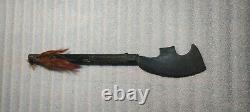
- Wood From Original
- Age
- Artist
- African Artists (3)
- Charles A. Morris (3)
- Charles Messina (3)
- Dick Libby (3)
- Elena Kotliarker (3)
- Georges Roualut (6)
- Kampol Prompichai (2)
- Kasamatsu Shiro (3)
- Kato Teruhide (4)
- Kono Bairei (3)
- Madeline Wood (7)
- Osuga Yuichi (2)
- Paul Hedrich (3)
- Purvis Young (5)
- Rob Vetter (7)
- Salvador Dalí (2)
- Steve Keene (8)
- Taylor (tj) Lynde (9)
- Unknown (66)
- Unsigned (3)
- ... (3970)
- Department
- Item Length
- Signed By
- Size
- 12\ (2)
- 17 X 23cm (3)
- 3.5 X 4 In (2)
- 32 X 13cm (3)
- 36.5 X 24cm (9)
- 53 X 42cm (3)
- 8” (3)
- Assorted (2)
- Full (2)
- Giant (over 60in.) (6)
- King (3)
- Large (71)
- Large (up To 60in.) (28)
- Medium (130)
- Medium (up To 36in.) (121)
- Mittel (2)
- See Description (2)
- Small (49)
- Small (up To 12in.) (32)
- Standard (2)
- ... (3640)
Antique NAGA Konyak knife from Nagaland collective Art North East India Art NG3






BRING HOME THE ART OF NAGALAND (INDIA). FEEL FREE TO LET ME KNOW IF YOU HAVE ANY FURTHER INQUIRE. ORIGIN = NORTH EAST PART OF INDIA. Length of Knife = Total Length includes wood handle 64 cm, Width 4 cm. Width of metal (Knife) = 10 cm.
FROM Nagaland (North Eastern Part of India). Apart from cultural contacts with the neighboring Ahoms, the ruler of Assam from 1228, the Naga had little or no contact with the outside world, including that of greater India, until British colonization of the area in the nineteenth century.
In 1828, Britain annexed Assam following the Treaty of Yandabo in 1826. [3] In the 1830s, the British sent expeditionary forces, and in 1845, the colonial power succeeded in concluding a non-aggression pact with Naga chiefs, who formerly had attacked bordering areas in Assam. But the Naga repeatedly violated the agreement, continuing to raid in Assam. After the 1830s, British attempts to annex the region to India were met with sustained and effective guerrilla resistance from Naga groups, particularly the Angami Naga tribe. The British dispatched military expeditions and succeeded in building a military post in 1851 and establishing some bases in the region.
In 1878 the Angamis mounted raids on British camps. The British responded strongly, burning several rebel villages and crushing the resistance. Eventually the region came under the administration of the British.
The Naga hills have been an area of continued resistance as they had long been isolated from outside cultures. The development of a spirit of nationalism and sense of a common identity are relatively new concepts among the Naga people.According to their traditions, each village is an independent republic; initially, they wanted to be free from all outside domination. Europeans were struck by the Naga practice of headhunting. The taking of a head is a symbol of courage.
Naga headhunting includes mortification of the rival, ritual violence, cosmological balance, the display of manhood, cannibalism, prestige, and as a means of securing the services of the victim as a slave in the afterlife. The Naga tribes practice headhunting and preserved the heads of enemies as trophies! The Naga make all the goods they use, as was once common in many traditional societies: they make their own cloth, their own hats and rain-coats; they prepare their own medicines, their own cooking vessels, their own substitutes for crockery.Craft work includes the making of baskets, weaving of cloth, wood carving, pottery, metalwork, jewelry and bead-work. The Naga people are a conglomeration of several tribes inhabiting the North Eastern part of India and north-western Burma. The tribes have similar cultures and traditions, and form the majority ethnic group in the Indian state of Nagaland, with significant presence in Manipur, Arunachal Pradesh and some small population in Assam. The Naga speak various distinct Tibeto-Burman languages, including Sumi, Lotha, Sangtam, Angami, Pochuri, Ao, Mao (Emela), Inpui, Rongmei (Ruangmei), Poumai, Tangkhul, Thangal, Maram, and Zeme. In addition, they have developed Nagamese Creole, which they use between tribes and villages, which each have their own dialect of language.
As of 2012, the state of Nagaland officially recognises 17 Naga tribes. In addition, some other Naga tribes occupy territory in the contiguous adjoining states of Manipur, Assam, and Arunachal Pradesh, India; and across the border in Burma. Prominent Naga tribes include the Poumai, Sumi, Angami, Ao, Chakhesang, Chang, Khiamniungan, Konyak, Liangmai, Lotha, Pochury, Rongmei, Tangkhul, Thangal, Zeme, Mao. If more photo details needed feel free to let me know. Colors May slightly vary due to lightning, flash light while photo shoot and according to screen settings and resolution work.
We strictly aim at building trust with our Customers. Our customer Feed back is very important to us. Our pride is satisfying customer we want to achieve goal with your positive feed back. We assure you that we will resolve any issue you have.
